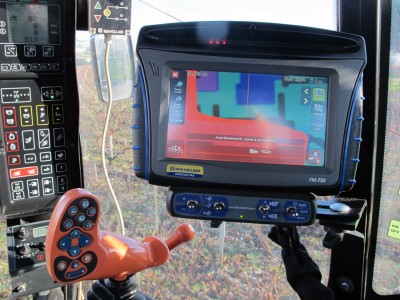Geolocated fertilization, a precision viticulture technique
Having georeferenced the entire property to establish a detailed map, Lynch-Bages has now introduced a geolocated fertilization technique throughout the estate. As technical director for Château Lynch-Bages, Nicolas Labenne explains what this state-of-the-art innovation actually involves.

Château Lynch-Bages is innovating again this year with its geolocated fertilization methods. What does this involve exactly?
Nicolas Labenne: "Our detailed knowledge of the vineyard combined with today's technological innovations allow us to use precision viticulture techniques. We can now adapt our spreading of organic and mineral fertilizers throughout the vineyard, even dividing areas less than 5 metres in length. This offers two advantages, not only can we reduce our use of fertilizer by 15 to 20% but also, above all, we can distribute products more effectively according to the needs of individual areas."
Why was this not possible before?
NL: "It required a lot of hard work. We began working on the idea in 2009 by conducting studies of soil resistivity and potential. We needed to measure the vineyard’s intra-parcel heterogeneity. This mapping, combined with plant-specific analyses, took us a long time but we have now distinguished five main soil types on the estate holding different qualitative potential. In 2009, we were already able to use this information to divide the land up into about 30 sub-areas to begin selective harvesting. Today, we are using our partners’ technological breakthroughs to take the process a step further and begin precision viticulture, using for example geolocated fertilization techniques."
What are the advantages for the vineyard, and ultimately for the wine?
NL : "This is where things become interesting. The quality of a wine depends on a multitude of important details. The techniques already used are beginning to yield results, for example better plant homogeneity and a must with more stable acidity levels and better sugar concentration. There is also an environmental impact, because this more judicious and precise form of viticulture is best for monitoring and sustainable development. This means the château will make input savings and we will soon be reducing our phytosanitary treatments too. We can also manage vineyard renewal and its long-term homogeneity more effectively."
Precision viticulture at Lynch-Bages: the key facts
Step 1: observation
In 2009, we georeferenced Lynch-Bages in detail (rows, orientation, length, actual planted surface, etc.), using satellites, drones and GPS to obtain more information about the vineyard.Step 2: characterization
The data showed the vineyard to be very variable, and so we divided the land up into new intra-parcel zones.Step 3: recommendation
We then completely revised and optimized the estate's viticulture strategy (thinning, fertilization, renewal, etc.).Step 4: implementation
We carried out the first geolocated fertilization tests in 2012. The tractor's GPS contains the information on the georeferenced map, meaning input can be controlled by either varying the spreader's flow (mineral fertilizer) or varying the speed at which the tractor moves forward (natural plant compost). The entire production cycle (thinning, renewal, selective harvesting, etc.) has benefited from these innovations.